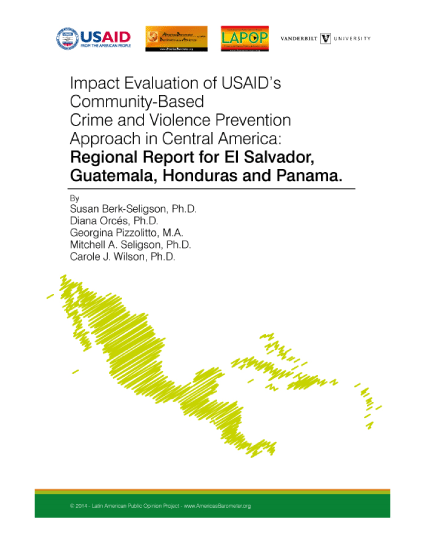Executive Summary
I. Background
The countries of Central America — especially “the Northern Triangle” of Guatemala, El Salvador, and Honduras — are among the most criminally violent nations in the world. As part of the U.S. Government’s (USG) Central America Regional Security Initiative (CARSI), the U.S. Agency for International Development (USAID) has designed and implemented a set of programs to improve citizen security in Central America by strengthening community capacity to combat crime and by creating educational and employment opportunities for at-risk youth.1 USAID’s crime prevention work has been implemented through its field Missions in five countries: El Salvador, Guatemala, Honduras, Nicaragua, and Panama.
USAID/Washington, via its Cooperative Agreement with the Latin American Public Opinion Project (LAPOP) at Vanderbilt University,2 asked LAPOP to design and carry out an impact evaluation of the crime prevention interventions under CARSI in Guatemala, El Salvador, Honduras3, and Panama.
This evaluation is part of a broader effort to determine the effectiveness of community-based crime prevention, in contrast to the traditionally more common law enforcement, or mano dura (“iron fist”), approach to addressing the widespread crime and violence permeating Central America. The crime prevention approach attempts to address the root causes of crime, rather than deal with crime after it has become endemic.
This multi-method, multi-country, multi-year evaluation was designed to contribute to an understanding of the effectiveness of USAID’s community-based crime and violence prevention approach. This package of interventions – that is, the “treatment” in this impact evaluation – includes activities such as planning by municipal-level committees; crime observatories and data collection; crime prevention through environmental design (such as improved street lighting, graffiti removal, cleaned up public spaces); programs for at-risk youth (such as outreach centers, workforce development, mentorships); and community policing. USAID’s community-based crime prevention projects are inherently cross-sectoral. That is, they integrate education and workforce development, economic growth and employment, public health, and governance interventions.
This scientifically rigorous impact evaluation is based on recommendations found in the comprehensive study by the National Academy of Sciences (National Research Council 2008). 4 It presents a summary of the main findings for the region as a whole. For each of the four focus countries, a more extensive, detailed country-level report has been prepared and is available online at http://www.vanderbilt.edu/lapop/carsi-study.php.
1 See http://www.whitehouse.gov/ondcp/central-america, http://www.state.gov/documents/organization/148416.pdf.
2 AID-598-A-00-06-00061.
3 The program in Honduras was delayed because of political unrest there in 2009, and therefore in this regional report the Honduras study includes only two rounds, rather than the three rounds carried out in Guatemala, El Salvador, and Panama. Variations in the methodology employed in Honduras and Panama were necessary in order to be responsive to changing USAID requirements. The individual country reports explain those differences.
4 One of the authors of this report, Mitchell A. Seligson, was a member of the National Academy of Science committee that wrote the study cited above.








Comment
Make a general inquiry or suggest an improvement.